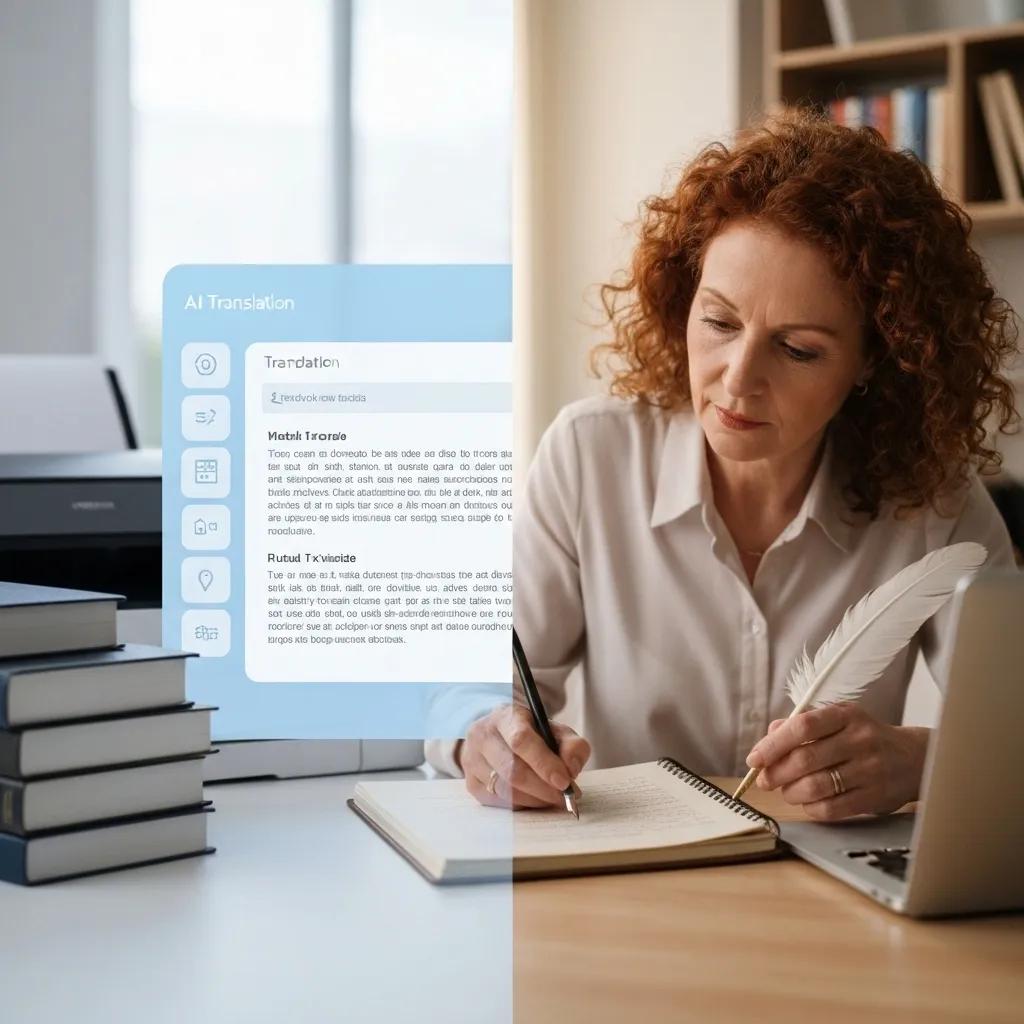AI Translator Online vs. Professional Service: Which Is Right for Your Next Project?

Selecting the optimal translation method is crucial for effective global communication. Online AI translation services provide swift, budget-friendly solutions for extensive content needs, whereas professional translation services ensure cultural accuracy and precision for sensitive materials. This guide clarifies what AI translation online and professional human translation entail, contrasts their accuracy, cost, speed, contextual grasp, security, and industry expertise, outlines when to opt for AI, human, or a combined workflow, and examines future trends and ethical considerations to guide your upcoming projects.
What Is AI Translation Online and How Does It Work?
AI translation online leverages neural machine translation and advanced language models to convert text between languages instantaneously, slashing turnaround times and costs while maintaining a foundational fluency through pattern recognition and analysis of bilingual data. This technology-driven method scales effortlessly to massive content volumes by processing requests in real time. Grasping these fundamental mechanisms sets the stage for exploring specific enabling technologies.
What Technologies Power AI Translation?
The primary components of AI translation, their functions, and their influence on output quality include:
- Neural Machine Translation: This technology uses sequence-to-sequence learning to enhance contextual coherence in translations.
- Large Language Models: These models leverage predictive text generation to boost contextual flexibility.
- Translation Memory: By reusing prior translations, this technology ensures project consistency.
These technologies are the bedrock of the speed and consistency characteristic of AI translation online, highlighting the key advantages that follow.
Brown, P. F., et al., Computational Linguistics (1990)
The Role of Neural Machine Translation in Modern Translation Workflows
Neural Machine Translation (NMT) has significantly boosted the accuracy and fluency of machine translation, particularly in maintaining contextual coherence. NMT models employ sequence-to-sequence learning to better comprehend the context of words within a sentence, leading to more precise and natural-sounding translations. This technology is a cornerstone of contemporary AI translation tools, improving their capacity to handle intricate language structures and subtleties.
What Are the Main Advantages of AI Translation?
AI translation online offers several benefits that align with modern content workflows:
- Instant Turnaround expedites project timelines by delivering real-time translations.
- Cost-Effectiveness reduces per-word expenses to a fraction of human rates.
- Scalability manages bulk content without creating resource bottlenecks.
- 24/7 Availability guarantees round-the-clock access for urgent tasks.
- Consistent Output utilizes translation memory for uniformity.
Collectively, these advantages position AI translation as the preferred solution for high-volume, time-sensitive translations, leading us to the top tools available.
Which AI Translation Tools Are Most Popular?
Leading AI translators showcase diverse strengths in accuracy, language support, and integration capabilities:
- DeepL combines neural networks with user input for nuanced translations of European languages.
- Google Translate utilizes extensive multilingual training data for broad language coverage.
- ChatGPT employs conversational LLM features to adapt tone and style as needed.
These tools exemplify how specialized and general-purpose AI platforms cater to varied translation requirements, guiding the choice between professional and automated methods.
What Is Professional Human Translation and Why Is It Important?

Professional human translation involves certified linguists or subject matter experts who convert content while preserving cultural nuances, idiomatic accuracy, and adherence to domain-specific terminology, ensuring messages connect authentically with target audiences. This human-centric approach maintains tone, legal compliance, and brand voice, which is vital for high-stakes or sensitive materials.
Who Are Professional Translators and What Expertise Do They Bring?
Professional translators are skilled linguists, often holding certifications from reputable associations, who specialize in particular industries or language pairs. Their expertise encompasses:
- Certification Credentials from bodies like the American Translators Association.
- Subject Matter Mastery in fields such as medical, legal, or technical terminology.
- Cultural Competence to adapt content for regional idioms and societal norms.
By blending linguistic proficiency with domain knowledge, professional translators deliver the accuracy essential for critical communications, leading to considerations of cultural nuance.
How Does Human Translation Ensure Cultural Nuance and Contextual Accuracy?
Human translation preserves cultural relevance by understanding idioms, tone, register, and audience expectations:
- Local Adaptation tailors metaphors and expressions for regional audiences.
- Tone Preservation maintains a formal or conversational style.
- Contextual Sensitivity recognizes cultural taboos and social norms.
- Localization Practices appropriately adjust formats, measurements, and references.
These subtleties ensure meaning extends beyond literal words, highlighting the core benefits of professional translation services.
What Are the Key Benefits of Professional Translation Services?
The essential benefits provided by human translation include:
- Accuracy: Precision in terminology and grammar prevents misinterpretation in critical text.
- Legal Compliance: Adherence to regulations and contracts ensures enforceable, binding translations.
- Confidentiality: Secure handling under NDAs and privacy standards protects sensitive data and proprietary content.
- Cultural Adaptation: Localization of idioms, tone, and cultural references engages the target audience authentically.
These benefits underscore why professional translation remains indispensable for high-value content, setting the stage for direct comparisons with AI systems.
How Do AI Translation and Professional Services Compare on Accuracy and Quality?
Comparing AI and human translation reveals distinct performance metrics in accuracy and quality, stemming from technological capabilities versus human cognitive abilities. Analyzing these metrics clarifies which method best suits different project needs.
What Accuracy Levels Can You Expect from AI vs. Human Translation?
AI translation accuracy typically falls between 70–85%, while professional human translation achieves 95–100% accuracy, assessed through fluency and adequacy evaluations by bilingual reviewers.
Hutchins, W. J., Machine Translation: Past, Present, Future (1999)
Human vs. Machine Translation: A Comparative Analysis of Accuracy and Quality
Studies comparing human and machine translation consistently show that human translation achieves higher accuracy rates, typically between 95-100%, compared to AI translation, which ranges from 70-85%. Human translators excel in understanding cultural nuances, idioms, and context, which are crucial for producing high-quality translations that resonate with the target audience.
These figures highlight the precision disparity and explain how contextual understanding further influences quality.
How Does Contextual Understanding Affect Translation Quality?
Contextual understanding enhances quality by ensuring idioms and cultural cues retain their intended meaning:
- Idiomatic Interpretation correctly renders expressions.
- Tone and register sustain the author's voice.
- Cultural References align with audience norms.
- Pragmatic Awareness adjusts for implied meanings.
As AI often struggles with nuanced context, human translators excel in these areas, prompting a look at the role of domain expertise.
What Role Does Industry-Specific Expertise Play in Translation Quality?
Industry-specific expertise guarantees correct terminology and compliance in specialized fields:
- Legal Documents require precise legal vocabulary.
- Medical Reports demand accurate clinical terminology.
- Technical Manuals need standardized technical language.
- Financial Statements adhere to regulatory definitions.
Bowker, L., & Cronin, M., Routledge Handbook of Translation and Technology (2020)
The Impact of Domain Expertise on Translation Quality
Specialized knowledge in a particular field, such as legal, medical, or technical, is essential for accurate translation. Translators with domain expertise can ensure that terminology is correct and that the translated content complies with industry-specific standards and regulations. This expertise is critical for maintaining the integrity and reliability of translated documents in regulated fields.
Subject matter knowledge ensures dependable translations in regulated domains, transitioning into cost-and-speed comparisons that affect project feasibility.
How Do AI and Human Translation Compare in Cost and Speed?
Cost and speed are key differentiators between AI translator online services and professional human translation, impacting budgets and delivery schedules.
What Are the Typical Costs of AI Translation vs. Professional Services?
AI translation often costs between $0.004 and $0.10 per word, while professional human translation ranges from $0.08 to $0.25 per word, with potential hidden fees like post-editing or rush charges.
These cost structures inform budget planning and lead to delivery speeds.
How Fast Can AI Translation Deliver Compared to Human Translators?
AI translation provides instant results, whereas human translation turnaround times can span days to weeks, depending on volume and specialization:
- AI Processing completes text conversion in mere seconds.
- Human Drafting requires time for translation, review, and revisions.
- Peak Demand Management may extend human workflow timelines.
Instant AI output is ideal for urgent tasks, while human workflows accommodate depth and accuracy.
How Does Scalability Impact Choosing Between AI and Human Translation?
Scalability influences method selection based on volume and deadline requirements:
- High-volume content is well-suited for AI’s bulk processing capabilities.
- Team Coordination can augment capacity for human projects.
- Quality Maintenance necessitates reviewer oversight at scale.
- Deadline Flexibility dictates resource allocation strategies.
Evaluating scalability ensures the chosen approach meets both volume and quality demands before exploring decision frameworks.
When Should You Use AI Translation, Professional Services, or a Hybrid Approach?
Deciding between AI translation, professional services, or a hybrid workflow hinges on content sensitivity, volume, and quality requirements, guiding optimal resource allocation.
What Are Ideal Use Cases for AI Translation?
AI translation excels in scenarios where speed and volume take precedence over nuanced accuracy:
- Internal communications such as emails or Helpdesk FAQs.
- Bulk product descriptions for e-commerce catalogs.
- User-generated content moderation across multiple languages.
- Routine website localization updates under tight deadlines.
- Preliminary drafts for in-house review and editing.
These use cases highlight when automated efficiency is sufficient, transitioning to situations where human expertise is essential.
When Is Professional Translation Necessary?
Professional translation is critical for content demanding precision, cultural resonance, or legal enforceability:
- Legal contracts and compliance documents.
- Marketing campaigns and brand storytelling.
- Medical research publications and patient information.
- Financial reports and investor communications.
- Creative content requiring nuanced tone and style.
Identifying these contexts clarifies where human translators provide indispensable value, before exploring hybrid models.
How Does Hybrid Translation Combine AI Speed with Human Accuracy?

Hybrid translation integrates AI-generated drafts with human post-editing to achieve rapid delivery and high fidelity. The workflow stages include:
- AI Drafting: An AI Translation Tool provides an immediate baseline translation.
- Post-Editing: A Human Translator refines cultural nuance and accuracy.
- Quality Assurance: A Bilingual Reviewer performs final validation and consistency checks.
By merging machine speed with human expertise, hybrid workflows effectively balance cost, speed, and quality for a wide array of projects.
What Are the Security, Privacy, and Ethical Considerations in AI vs. Human Translation?
Security, privacy, and ethical considerations play a significant role in translation choices, influencing data confidentiality, compliance, and responsible usage in both AI and professional contexts.
How Does AI Translation Handle Data Security and Confidentiality?
AI translation routes data through cloud APIs, raising questions about storage and access controls:
- End-to-End Encryption safeguards data during transit.
- Data Retention Policies dictate storage duration.
- On-Premises vs. Cloud Deployment impacts the level of control.
- Regulatory Compliance with standards like GDPR, HIPAA, or others.
Understanding these safeguards aids in risk assessment and contrasts with the protocols of human services.
What Ethical Concerns Arise with AI Translation Use?
AI translation brings forth ethical considerations related to bias, transparency, and accountability:
- Training Data Bias can perpetuate existing stereotypes.
- Lack of Audit Trails limits the traceability of errors.
- Cultural Misrepresentation risks causing offense or spreading misinformation.
- Responsibility for Errors remains unclear without human oversight.
Awareness of these concerns supports responsible implementation and frames the ethical standards of professional services.
How Do Professional Services Ensure Confidentiality and Legal Compliance?
Professional translation services enforce stringent confidentiality and regulatory adherence through:
- Non-Disclosure Agreements and data handling contracts.
- Secure Workflows utilizing encrypted file transfers.
- Industry Certifications for translators and agencies.
- Professional Indemnity Insurance covering liability for errors.
These measures guarantee data protection and legal compliance for high-value content.
What Are Future Trends and Innovations in AI and Professional Translation?
Emerging trends in translation encompass AI-driven advancements, hybrid workflows, and evolving ethical standards that are shaping the industry's future.
How Are Advances in AI Improving Translation Accuracy and Capabilities?
Recent AI innovations enhance translation through:
- Zero-Shot and Few-Shot Learning enabling new language pairs without explicit data.
- Domain Fine-Tuning for industry-specific terminology.
- Multimodal Translation integrating text, audio, and image inputs.
- Collaborative AI-Human Loops where feedback continuously refines models.
These improvements promise higher baseline accuracy and broader applicability in the coming years.
What Is the Growing Role of Hybrid Translation Models?
Hybrid models are becoming standard by integrating machine efficiency with human judgment in:
- Scalable Human-in-the-Loop Systems for large-scale projects.
- Automated Quality Scoring to flag segments requiring review.
- Incremental Model Training using edited outputs.
- Cost-Optimized Workflow Design balancing speed and reviewer availability.
This blended approach maximizes both speed and precision as translation volumes continue to expand. Learn more about our certified translation services.
How Will Ethical Standards Shape the Future of Translation Services?
Ethical standards will guide translation evolution through:
- AI Ethics Guidelines promoting transparency and fairness.
- Provider Certifications ensuring responsible AI utilization.
- Strengthened Privacy Regulations for data sovereignty.
- Industry Best Practice Frameworks covering bias mitigation and accountability.
These frameworks will steer both AI and human services toward greater trust and reliability.
Choosing the right translation approach involves balancing speed, cost, quality, and context to align with project priorities. Online AI translation solutions excel in high-volume, low-stakes scenarios, while professional services maintain precision and cultural fidelity. Hybrid workflows offer a balanced compromise for fast, accurate results. Align your translation strategy with specific content requirements to maximize your global impact.








